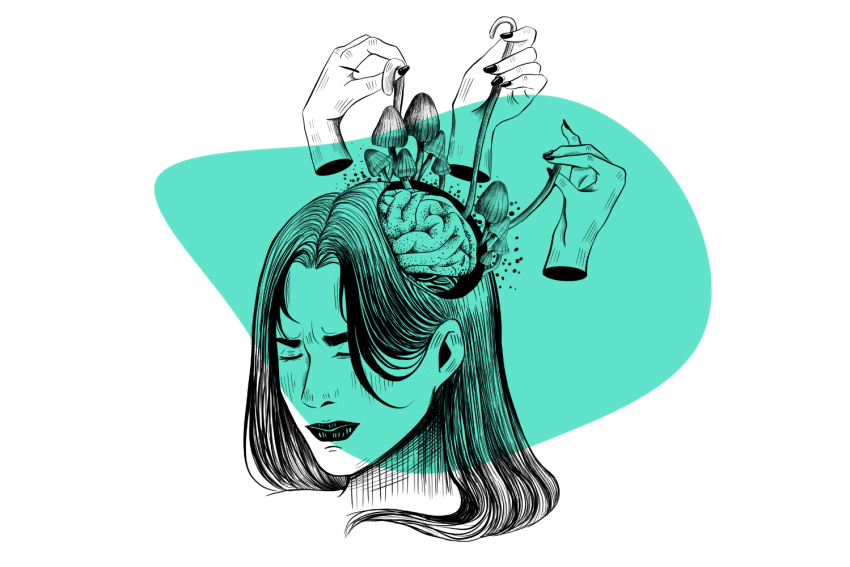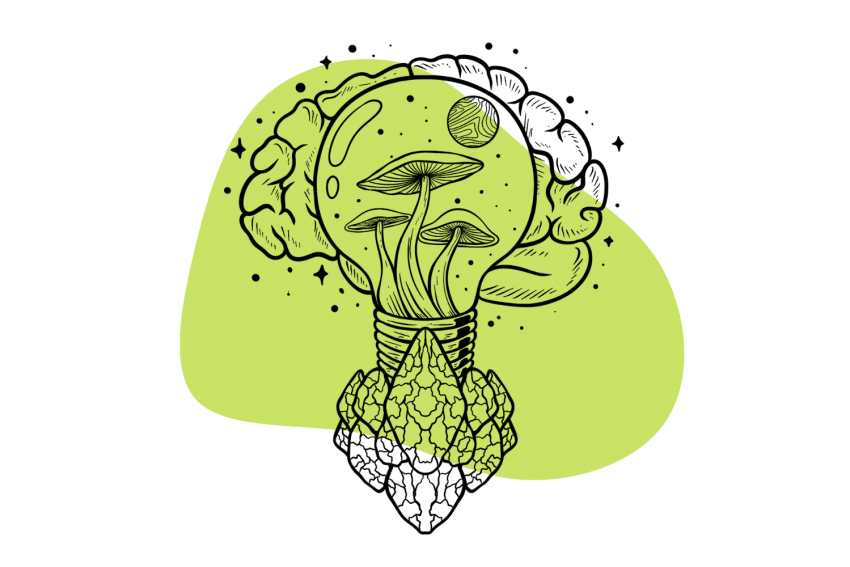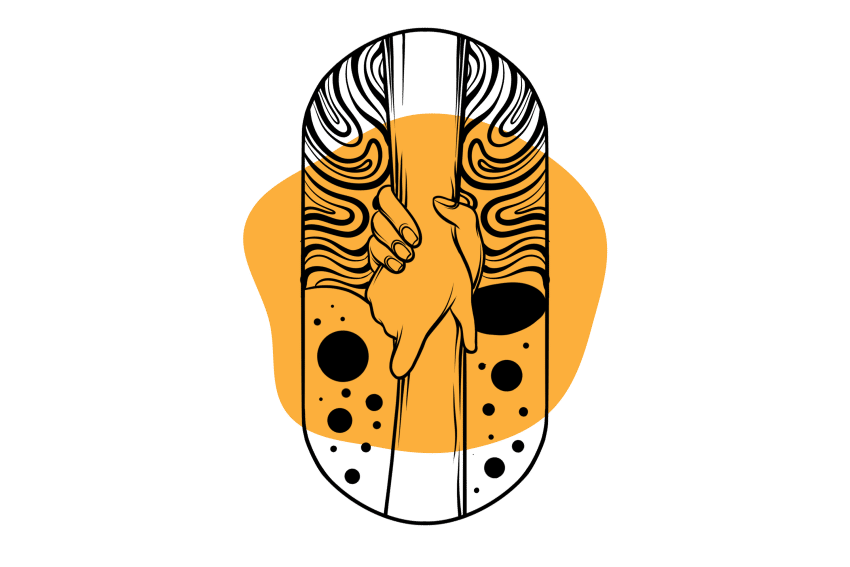Can Psychedelics Treat Narcissism? (Emerging Field of Study)
Narcissism is notoriously difficult to treat, but could psychedelics bring about ego death 🪦 essentially removing or reducing narcissistic traits while increasing empathy?
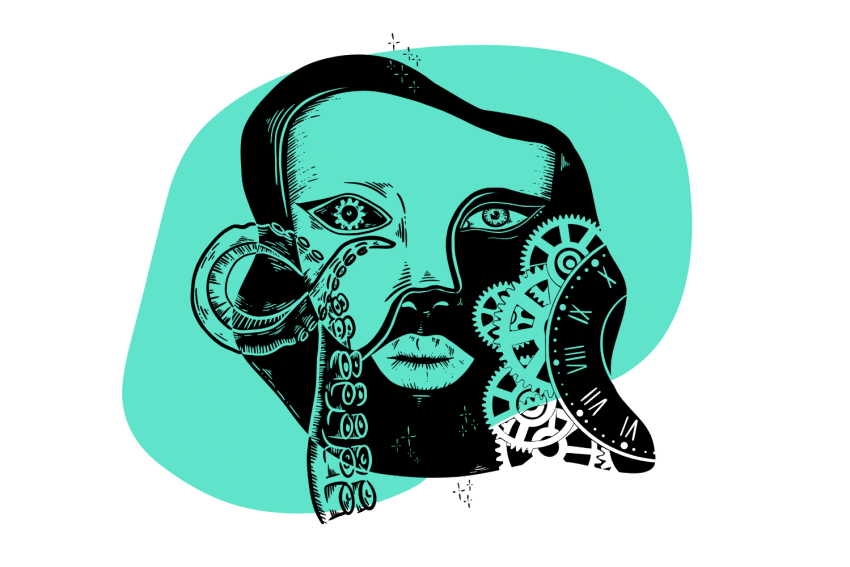
There is limited research on psychedelics as a way to treat narcissism, but it’s possible that some of the effects of different psychedelics in conjunction with therapy may help expand the narcissist worldview to a more empathic and less self-centered to one more inclusive of others.
If you’re wondering whether psychedelics can “heal” narcissism, there is a chance you suspect someone in your circle has some degree of a narcissistic personality. You may have dealt with a manipulative partner or have noticed patterns of behavior in a loved one that seems to fit the traits of narcissism and are now asking yourself: is there anything you can do to help them change them?
Could psychedelics be the answer?
Let’s dive into the world of narcissistic personalities and the unique potential psychedelics may offer in terms of treatment.
How Psychedelics May Be Used to Treat Narcissism
Research has led to a consensus that certain psychedelics may potentially help treat mental disorders, including anxiety, depression, and PTSD. Unfortunately, research about disorders such as NPD is still in its infancy, and currently, there is no clarity on whether psychedelics can help treat maladaptive narcissism [19].
With that said, certain facts about psychedelics may hint to promise for future research.
It’s currently understood that psychedelics can boost pro-social attitudes and address problematic behavior patterns [19], which could be supportive for NPD patients.
These pro-social changes can come from certain aspects of the psychedelic experience, such as increased levels of empathy, a sense of connectedness with others and transcendence of self, and ego death.
1. Enhanced Empathy
One of the main traits of NPD is a lack of empathy and regard for others. Because of this, it’s natural to ask: can psychedelics increase empathy? If this was the case, maybe narcissism and other empathy-related disorders could, after all, be cured.
Psychedelics like psilocybin and MDMA have improved emotional empathy [20, 21]. Similarly, research on LSD has shown increased empathy levels; subjects report feeling closer to others and a sense of caring for and wanting to be with others [22].
It’s important to differentiate emotional empathy from cognitive empathy. Emotional empathy measures the subjective experience of other people’s emotions (how I feel about other people’s emotions), while cognitive empathy refers to the ability to identify other people’s emotions [21] accurately.
Although psilocybin has shown changes in emotional empathy, it does not seem to affect cognitive empathy. Learning to identify others’ feelings may take more than a simple mushroom trip. However, emotional empathy could bring awareness to the emotional response toward other people’s feelings, which may be a stepping stone for developing a stronger sense of empathy.
2. Awe & Ego Death
Another mechanism through which psychedelics may keep narcissism in check is through the frequently experienced sense of awe and vastness that psychedelics may induce. This experience can lead to a reduced sense of self [23]. Narcissism is often characterized by an excessively inflated sense of self (especially in grandiose cases), so an experience of awe may put narcissistic beliefs and maladaptive behaviors into perspective.
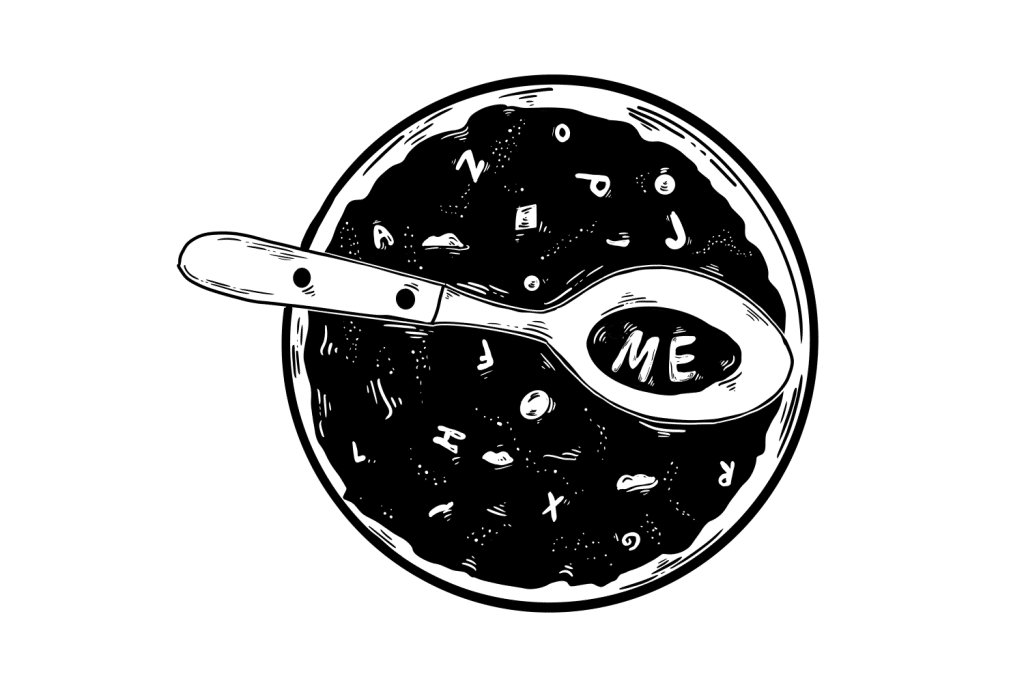
Similarly, ego death or ego dissolution may be a catalyst for change in narcissistic personalities. Ego dissolution is the experience of detaching from the self or sense of self. An experience of this nature could very well give a glimpse into a view of the world that is not self-focused, which could lead to a shift in perspective [20].
3. Connectedness & Transcendence
Another aspect of the mystical experience commonly reported by psychonauts is a deep sense of connectedness with everyone and everything around them. Experiences of ego dissolution and awe can create a feeling of connectedness to others [24].
This sense of connectedness can shift the center of attention away from the self. Feelings of connectedness paired with a greater sense of empathy and a diminished sense of self-importance could potentially lead to more pro-social and pro-environmental behaviors that oppose classic narcissistic behaviors.
4. Balovaptan & The Ruthlessness Gene
Scientists have recently discovered the so-called “ruthlessness gene,” — which has been found to be involved in the process of empathy (more on this later). This is important to bring up because balovaptan (RG7314), an atypical benzodiazepine, may play a role in how this gene expresses itself in cognitive and behavioral processes.
Most research on this drug focuses on autism spectrum disorder (ASD). The research regarding its effects on empathy and narcissism is very limited. However, it’s believed that balovaptan acts on the V1A receptor (V1AR) [25], meaning it could theoretically play a role in processes of cognitive empathy.
It’s important to note that, as is the case with all psychedelic treatments, growth comes from a process of integration that is often best done under the guidance of a trained professional such as a psychotherapist or a skilled traditional healer like a shaman.
Dr. Ramani states that a trip alone is not enough to fix narcissism-related issues and warns that in many cases, narcissists who go into the spiritual journey of psychedelics may easily fall into the trap of spiritual bypassing: another way to 1) avoid doing the actual inner work to address vulnerability and maladaptive patterns, and 2) to further encourage feelings of “I am more spiritual than you” superiority that leads to devaluation and judgment of others and the use of spirituality as a justification for more abuse and manipulation.
These traits of spiritual narcissism are rampant in new-age spirituality but are not new by any means. After all, many religions have a sort of collective sense of superiority and see other faiths and practices as inferior, unholy, and deviant, an attitude that celebrates narcissistic traits.
What is Narcissism?
The word narcissism has lost much of its true meaning as it has become more and more used in mainstream conversation. You may have caught yourself or someone else saying something like “he’s just a narcissist” because they take a lot of selfies or “I always end up dating narcissists” because there’s always some form of conflict in the relationships — but these kinds of statements may be false.
It’s important to understand that narcissism is a spectrum and that the term “narcissism” is not equal to narcissistic personality disorder (NPD). This spectrum exists between mild narcissistic traits that we all have to an extent (feelings of self-importance, attention-seeking behaviors, etc.) and actual narcissistic personality disorder, the most extreme manifestation of narcissistic traits and behaviors.

NPD is a diagnosable disorder with certain traits the mainstream understanding of “narcissism” may be missing.
There’s a stereotype associated with the term “narcissism.” This image is often of a successful person, male, attractive by social standards, entitled, arrogant, with feelings of grandiosity, and whose relationships are exploitative and one-sided. This type of manifestation of NPD is known as narcissistic grandiosity, or grandiose narcissism, where the above symptoms are observable — but behind it, there’s often a hidden picture of poor self-esteem.
On the opposite end of narcissistic grandiosity, we have narcissistic vulnerability or vulnerable narcissism. In vulnerable types of narcissism, there is usually an external manifestation of low self-esteem and lack of self-confidence with an inner sense of superiority. The traits that are observable to an outsider are known as overt narcissism traits, while those symptoms that are only experienced by the person in their inner, private world are referred to as “convert narcissism” [1].
As the name states, NPD is a personality disorder: a divergent way of thinking of oneself and relating to others. More specifically, NPD falls into the cluster B personality disorder category alongside antisocial personality disorder, borderline personality disorder, and histrionic personality disorder. These disorders are characterized by unpredictable behavior, emotional volatility, inappropriateness, and potential violence [2].
How is NPD Diagnosed?
According to the DSM-V, the current standard psychiatric diagnostic tool, NPD has certain required characteristics for diagnosis in terms of function in different aspects of life, including personal, interpersonal, and pathological personality traits.
Personal (Self-Functioning) Traits
The personal or self-functioning real traits are divided into identity and self-direction.
Identity characteristics include:
- Excessive reliance on external validation for a sense of self and self-esteem
- Exaggerated inflated or deflated self-appraisal (aka feelings of grandiosity or defeat)
- Fluctuating self-esteem
Self-direction characteristics include:
- Goal setting that is based on getting outside approval
- Lack of awareness of one’s own motivations
- Either excessively high or low personal standards (high to accommodate feelings of grandiosity and low due to a sense of entitlement)
Interpersonal Functioning
The interpersonal realm is divided into empathy and intimacy traits.
Empathy traits include:
- Difficulty identifying with the feelings and needs of others (impaired ability to empathize)
- Excessive attention to the reactions of others that are relevant to self
- Distorted appraisal of one’s effect on others (either over or underestimating)
Intimacy traits include:
- Superficial relationships usually only serve self-esteem regulation
- Little interest in others, which affects a sense of cooperation or mutuality
- Relationships only for personal gain
Pathological Personality Traits
Pathological personality traits in NPD include grandiosity and attention-seeking.
Grandiosity implies that the person:
- Has great feelings of entitlement
- Believes that they are better than others
- Condescending attitude toward others
Attention seeking implies that the person:
- Excessively seeks to be the center of attention
- Seeks admiration and praise from others
These are the main characteristics of NPD. However, having these traits is not enough for a diagnosis.

A diagnosis can only be made if the following conditions are also present:
- The traits are stable through time and in different situations
- The traits are not explained by development stages that can adequately apply to the patient or to socioeconomic or cultural factors
- The traits are not due to the effects of substance use or a medical condition
For more information, read the full explanation of diagnostic criteria for NPD and other personality disorders.
NPD does not exist on its own. Frequent comorbidities of NPD include depression, suicidal ideation, eating disorders, substance abuse, and other cluster B personality disorders. Additionally, NPD can often go misdiagnosed as some of its symptoms can be confused with other affective disorders.
What Causes Narcissism?
Narcissism may have genetic, epigenetic, and interpersonal causes. Although there could be a genetic predisposition to narcissism, the development of the disorder is generally epigenetic [3, 4], meaning that the environment, upbringing, and development conditions play a large role in whether these genetic traits manifest or not.
1. Genetics
The research on the genetic components of narcissism is not extensive, but it does hint at a potential level of genetic heritability. A 2008 study found that cluster B personality disorders have different degrees of heritability, with NPD having the lowest heritability rate of 24% and antisocial personality disorder the highest at 38% [5].
What about the ruthlessness gene?
You may have read about the discovery of a so-called “ruthlessness gene.”
This gene, or arginine vasopressin receptor 1a (AVPR1a), has been associated with processes of cognitive empathy [6].
Though discoveries of this nature are indeed intriguing, reducing personality traits to a single genetic correlation is nearly impossible, and arriving at conclusions on whether personality disorders are genetically inherited is therefore extremely challenging [7].

Additionally, this way of thinking solely from the bio-genetics leads to a reductionist view of psychological development, which lacks the nuance of how sociocultural environment, upbringing, and childhood experiences influence psychology, personality, and behavior.
In short, yes, there could be a genetic link to NPD. But genetics is not everything and often represents a predisposition rather than a destined fate. Epigenetics state that environment and experience can shape how genes manifest and are expressed. Looking at these aspects may yield more understanding of how NPD develops and that a specific gene is just a small part of the equation.
2. Developmental Environment
It’s well understood that childhood experiences inform the psychology and behavior of individuals later in life. Some of the most critical aspects of these early experiences include attachment processes, parenting styles, and familial atmosphere and relationships, to name a few.
Attachment Processes
Attachment theory posits that all mammals seek attachment to their caregiver as a means of survival and that having a caregiver who is responsive to the child’s attachment-seeking behaviors (crying, searching, etc.) helps develop a secure attachment.
Secure attachments lead to the development of children who are confident and secure in their exploration of the world while knowing that they can rely on the support of their caregivers. However, when attachment needs aren’t met, be it by a dismissive parent who constantly ignores the child’s needs, an intermittent presence of a caregiver, an unpredictable relationship ridden with volatile emotions, or even an overprotective parent that allows for no independence, can lead to maladaptive attachment patterns. The two most common maladaptive attachment styles are avoidant attachment and anxious or anxious-resistant attachment.
Those with avoidant attachment do not seem distressed with separation from their caregiver and avoid contact with them upon return. These types tend to avoid connection or meaningful attachment to relationships.
On the other hand, anxious-resistant types deeply long for comfort from the caregiver but also push back or punish them when they are present. These types tend to seek constant reassurance and validation from their relationship and may lash out or be distressed when attachment needs aren’t met [8].
The last couple of decades has shown increasing evidence that disruptions to the child-caregiver relationship can lead to patterns of relational attachment, such as anxious or avoidant attachment styles. These two types of attachment have been linked to vulnerable and grandiose narcissism, respectively [9, 10, 11]
Parenting Styles & Family Dynamics
Parental behavior has been given the most attention as a potential catalyst for NPD, and there is a general consensus that dysfunctional parenting is highly associated with the development of NPD [12].
Three aspects of parental attitudes seem to play a role in the development of personality and, therefore, of NPD: warmth, monitoring, and psychological control.
- Warmth: How much a parent or caregiver provides emotional support and resources to a child.
- Monitoring: How aware a parent is of the child’s actions.
- Psychological control: Psychological manipulation that hinders development (guilting, withdrawing love, or being possessive).
High levels of warmth with adequate monitoring can be protective factors against NPD. Traits of parental coldness, excessive strictness, aggression, and psychological control may provide fertile ground for the development of NPD. Similarly, high levels of warmth with no monitoring can lead to feelings of entitlement that can boost NPD traits [13].
Current Treatments for Narcissism
Treating those with NPD is a challenge that only certain counselors are willing to undertake. To begin with, people with NPD don’t tend to seek therapeutic support. Acclaimed narcissism specialist Dr. Ramani states that people with NPD tend to believe that any problems they may have are someone else’s fault and rarely seem to feel the need for guidance, support, or a new perspective. Because of this, people with NPD tend to ignore, dismiss, or skeptically scrutinize any insight that the therapist may offer [14], and that is if they even make it to the counseling office, to begin with.
A main issue in the therapeutic treatment of NPD lies in the dynamics of transference and countertransference. Transference is when clients project or place their feelings, beliefs, or desires onto the therapist. Similarly, countertransference is when the therapist directs their emotional response, desires, and beliefs to the client.

Transference and countertransference dynamics happen in all therapeutic relationships; many therapeutic modalities, as early as Freudian psychoanalysis, believe that skillfully navigating these dynamics is a key aspect of the therapeutic process. However, these dynamics can be incredibly challenging for the therapist to navigate in NPD cases, as these clients tend to project their feelings of superiority and grandiosity onto the therapists, making the therapist a devalued and inferior counterpart [14].
Despite the challenge, and maybe because of it, there is a growing interest in narcissistic personalities and the efficacy of different treatment modalities. Although research on treatment efficacy for NPD is scarce, some anecdotal evidence and small sample case studies have shown the success of certain modalities, including psychodynamic and behavioral approaches.
Psychodynamic Therapy
Psychodynamic therapy, which was born from Freudian psychoanalysis and evolved through the work of notable psychologists like Carl Jung and Alfred Adler, among others, focuses on relational and behavioral patterns, unconscious motivations for behavior, and the therapeutic relationship as a primary catalyst of change. Psychodynamic therapy believes that life experiences, especially those of early childhood, build and reinforce unconscious patterns, personality styles, and behaviors. These modalities seek to bring conscious awareness of these unconscious patterns and behaviors to the client, and the therapeutic relationship plays a large role in this process [15].
Some argue that psychodynamic therapy is best for those who already have some level of self-awareness and insight and that those who lack an ability for self-reflection, like many NPD clients, may find introspective exercises futile [15].
However, many professionals working with narcissistic dysfunctions still suggest relational psychodynamic approaches. Since these practices regularly point out behavioral and relational patterns, they can help build the client’s self-awareness and insight [16]. This can help clients navigate situations where their self-image is threatened, often triggering antisocial behavior in narcissistic personalities that can lead to significant relational challenges.
Behavioral Therapies (CBT & DBT)
Cognitive behavioral therapy (CBT), probably one of the most common approaches in clinical practice, holds some tenets that could support behavior change in NPD patients. One of the core principles of CBT is the belief that unhelpful beliefs and patterns of behavior are at the core of many relational and emotional difficulties [17].
Since NPD patients have both unhelpful ways of thinking (excessively elevated or deflated sense of self or feeling superior over others) and behavioral patterns (emotional manipulation, volatile emotional reactions, outbursts of aggression and abuse, etc.), helping to reframe these can lead to behavioral change in some cases. Some case studies have seen success with CBT modalities stating that behavioral modifications and cognitive techniques can help improve adaptive responses when faced with disappointment, frustration, or lack of gratification [18], experiences that are common to folks with NPD.
Dialectical behavior therapy (DBT) is a treatment designed for cases with strong emotional intensity, such as patients with borderline personality disorder (BPD). It uses tools from CBT, mindfulness, and acceptance principles [19]. DBT works on creating a balance between acceptance of the current emotional state or life situation and changing behavior to grow and improve.
BPD and NPD have many similarities in symptoms and diagnostic factors; this is especially true for vulnerable narcissism. Dialectic frameworks believe that emotional dysregulation is the root of borderline symptoms, something that is also valid for NPD. Given these similarities, it stands to reason that DBT approaches may show results for narcissistic behaviors [18].
More Resources for Narcissism
Whether you are just curious about human behavior or wondering if someone you know is on the narcissism spectrum, plenty of interesting material exists.
Here are some recommended reads and listens:
- Should I Stay or Should I Go – Dr. Ramani
- The 3 SIGNS You’re Dealing With A Narcissist & How To Set Boundaries – Dr. Ramani & Jay Shetty
- The Psychology of Narcissism – W. Keith Campbell
- The Handbook of Narcissism and Narcissistic Personality Disorder: Theoretical Approaches, Empirical Findings, and Treatments – W. Keith Campbell, Joshua D. Miller
- Narcissism and Insecure Attachment – Diana Diamond
- Narcissism vs. Narcissistic Personality Disorder – Dr. Ramani in MedCircle
- Are Narcissists Born or Made? – Psychology Element
TLDR: Psychedelics vs. Narcissism
Narcissism ranges from mild narcissistic traits to diagnosable narcissistic personality disorder. It’s developed by a combination of genetic heritability, emotional development environment, and family atmosphere.
Though there are therapeutic modalities that could help navigate narcissistic patterns, it’s a notoriously challenging personality to deal with, and some may never see any change.
It’s possible that the power of psychedelic experiences may help develop feelings of connectedness and empathy through the distancing of a self-centered view, but much research is still needed for any clear conclusions. This would only be possible with a long-term commitment to therapeutic support, introspection, and accountability.
References
- Pincus, A. L., Cain, N. M., & Wright, A. G. (2014). Narcissistic grandiosity and narcissistic vulnerability in psychotherapy. Personality Disorders: Theory, Research, and Treatment, 5(4), 439.
- Psychology Today. (n.d.). Cluster B. https://www.psychologytoday.com/us/basics/cluster-b
- Gescher, D. M., Kahl, K. G., Hillemacher, T., Frieling, H., Kuhn, J., & Frodl, T. (2018). Epigenetics in personality disorders: today’s insights. Frontiers in psychiatry, 9, 579.
- Svrakic, D. M., & Cloninger, R. C. (2010). Epigenetic perspective on behavior development, personality, and personality disorders. Psychiatria Danubina, 22(2), 153-166.
- Torgersen, S., Czajkowski, N., Jacobson, K., Reichborn-Kjennerud, T., Røysamb, E., Neale, M. C., & Kendler, K. S. (2008). Dimensional representations of DSM-IV cluster B personality disorders in a population-based sample of Norwegian twins: a multivariate study. Psychological medicine, 38(11), 1617-1625.
- Uzefovsky, F., Shalev, I., Israel, S., Edelman, S., Raz, Y., Mankuta, D., … & Ebstein, R. P. (2015). Oxytocin receptor and vasopressin receptor 1a genes are respectively associated with emotional and cognitive empathy. Hormones and behavior, 67, 60-65.
- Holden, C. (2008). Parsing the genetics of behavior. Science, 322(5903), 892-895.
- Fraley, R. C. (2018). Adult attachment theory and research: A brief overview. University of Illinois.
- Smolewska, K., & Dion, K. (2005). Narcissism and adult attachment: A multivariate approach. Self and Identity, 4(1), 59-68.
- Diamond, D., Levy, K. N., Clarkin, J. F., Fischer-Kern, M., Cain, N. M., Doering, S., … & Buchheim, A. (2014). Attachment and mentalization in female patients with comorbid narcissistic and borderline personality disorder. Personality Disorders: Theory, Research, and Treatment, 5(4), 428.
- Meyer, B., & Pilkonis, P. A. (2011). Attachment theory and narcissistic personality disorder. The handbook of narcissism and narcissistic personality disorder: Theoretical approaches, empirical findings, and treatments, 434-444.
- Horton, R. S. (2011). Parenting as a cause of narcissism: Empirical support for psychodynamic and social learning theories. The handbook of narcissism and narcissistic personality disorder: Theoretical approaches, empirical findings, and treatments, 181-190.
- Horton, R. S. (2011). Parenting as a cause of narcissism: Empirical support for psychodynamic and social learning theories. The handbook of narcissism and narcissistic personality disorder: Theoretical approaches, empirical findings, and treatments, 181-190.
- Kernberg, O. F. (2014). An overview of the treatment of severe narcissistic pathology. The International Journal of Psychoanalysis, 95(5), 865-888.
- Wedding, D., & Corsini, R. J. (2013). Current psychotherapies. Cengage Learning.
- Kealy, D., Goodman, G., Rasmussen, B., Weideman, R., & Ogrodniczuk, J. S. (2017). Therapists’ perspectives on optimal treatment for pathological narcissism. Personality Disorders: Theory, Research, and Treatment, 8(1), 35.
- American Psychiatric Association. (2017). What is cognitive behavioral therapy?. American Psychiatric Association. https://www.apa.org/ptsd-guideline/patients-and-families/cognitive-behavioral
- Miller, J. D., & Campbell, W. K. (2011). The Handbook of Narcissism and Narcissistic Personality Disorder: Theoretical Approaches, Empirical Findings, and Treatments. John Wiley & Sons.
- Van Mulukom, V., Patterson, R. E., & van Elk, M. (2020). Broadening your mind to include others: The relationship between serotonergic psychedelic experiences and maladaptive narcissism. Psychopharmacology, 237, 2725-2737.
- Pokorny, T., Preller, K. H., Kometer, M., Dziobek, I., & Vollenweider, F. X. (2017). Effect of psilocybin on empathy and moral decision-making. International Journal of Neuropsychopharmacology, 20(9), 747-757.
- Schmid, Y., Hysek, C. M., Simmler, L. D., Crockett, M. J., Quednow, B. B., & Liechti, M. E. (2014). Differential effects of MDMA and methylphenidate on social cognition. Journal of psychopharmacology, 28(9), 847-856.
- Dolder, P. C., Schmid, Y., Müller, F., Borgwardt, S., & Liechti, M. E. (2016). LSD acutely impairs fear recognition and enhances emotional empathy and sociality. Neuropsychopharmacology, 41(11), 2638-2646.
- Yaden, D. B., Le Nguyen, K. D., Kern, M. L., Belser, A. B., Eichstaedt, J. C., Iwry, J., … & Newberg, A. B. (2017). Of roots and fruits: A comparison of psychedelic and nonpsychedelic mystical experiences. Journal of Humanistic Psychology, 57(4), 338-353.
- Piff, P. K., Dietze, P., Feinberg, M., Stancato, D. M., & Keltner, D. (2015). Awe, the small self, and pro-social behavior. Journal of personality and social psychology, 108(6), 883.
- Jacob, S., Veenstra-VanderWeele, J., Murphy, D., McCracken, J., Smith, J., Sanders, K., … & Anagnostou, E. (2022). Efficacy and safety of balovaptan for socialisation and communication difficulties in autistic adults in North America and Europe: a phase 3, randomised, placebo-controlled trial. The Lancet Psychiatry, 9(3), 199-210.


